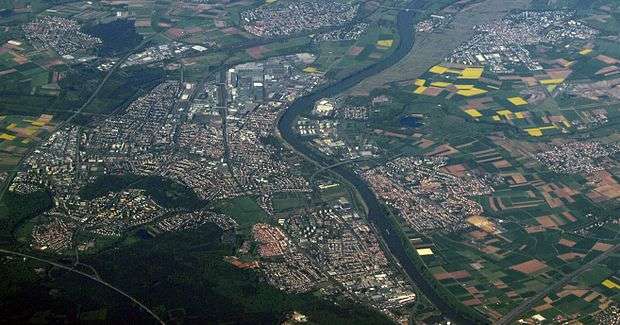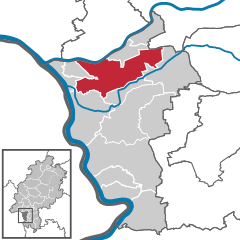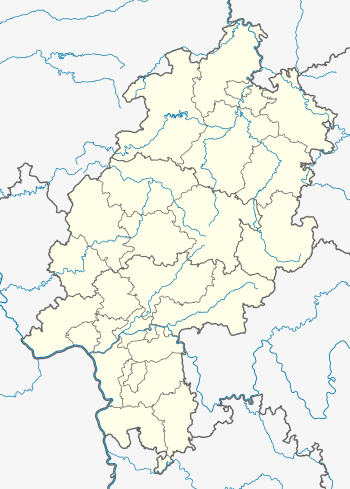Rüsselsheim am Main
Rüsselsheim am Main is the largest city in the Groß-Gerau district in the Rhein-Main region of Germany. It is one of seven special status cities (implementing several functions that counties normally provide) in Hesse and is located on the Main, between Frankfurt and Mainz, only a few kilometres from its mouth in Mainz. The suburbs of Bauschheim and Königstädten are included in Rüsselsheim. Rüsselsheim has attained international recognition through the presence of the German car company Adam Opel GmbH.
Rüsselsheim am Main | |
|---|---|
 Aerial view | |
 Coat of arms | |
Location of Rüsselsheim am Main within Groß-Gerau district   | |
 Rüsselsheim am Main  Rüsselsheim am Main | |
| Coordinates: 50°00′N 08°26′E | |
| Country | Germany |
| State | Hesse |
| Admin. region | Darmstadt |
| District | Groß-Gerau |
| Government | |
| • Lord Mayor | Udo Bausch (Independent politician) |
| Area | |
| • Total | 58.3 km2 (22.5 sq mi) |
| Elevation | 88 m (289 ft) |
| Population (2018-12-31)[1] | |
| • Total | 65,440 |
| • Density | 1,100/km2 (2,900/sq mi) |
| Time zone | CET/CEST (UTC+1/+2) |
| Postal codes | 65428 |
| Dialling codes | 06142 |
| Vehicle registration | GG |
| Website | www.ruesselsheim.de |
History
Rüsselsheim's foundation goes back to a Frankish colony in the first half of the 5th century. The first written mention of "Rucilesheim", or "the house of Rucile", is in an inventory of royal hunting rights around the year 840. Rüsselsheim emerged from a settlement of the Count of Katzenelnbogen.

Over time, the name of the city evolved from Rucilesheim to the current Rüsselsheim:
- 764/5 Rucile(n)sheim
- before 1130 Ruozcelenesheim
- 1336 Ruzelnsheim
- 1275 Ruozelsheim
- 1640 Ruselsem
- 1840 Rüsselsheim
In the year 1435 the high noble Count John IV of Katzenelnbogen[2] was the first to cultivate Riesling in Rüsselsheim. Annual reports record that his administrator bought new vines for 22 Schilling. In the following years riesling grapes were planted down the river Rhine and up the river Mosel. In the 18th and 19th centuries, Rüsselsheim made a new contribution to the history of wine when famous wine-growing estates in the Rheingau recultivated their vineyards with vines from the Rüsselsheim and Flörsheim Area (Allendorf, Rheingauer Weinbauverband EV 1980). After the First World War viticulture disappeared in Rüsselsheim. In 1980 the mayor of Rüsselsheim Dr. Karl-Heinz Storsberg set up a museum-vineyard near the castle which celebrates 550 Years of Riesling.
The town's population reached 1,422 by 1829, then doubled between 1875 and 1914 from 3,500 to 8,000. At the beginning of the Second World War, 16,000 people lived in Rüsselsheim; only 9,500 remained at the conflict's end. The population reached a new record of 63,000 inhabitants in 1978, with rapid post-war reconstruction fed first by refugees from the former German territories in Eastern Europe (Heimatvertriebene), then by immigrants attracted by the Opel factories. The proportion of people born overseas was 23% on 31 June 2014.[3]
Politics
Coat of arms
The city's coat of arms features a silver "Doppelhaken" (double hook) and two silver stars on a blue background.
The "Doppelhaken" is also called a "Wolfsangel" (wolf hook), once possibly used to kill wolves, or as a grappling hook. It is now forbidden in Germany to use this symbol on the grounds that it has been used in the past as a symbol of some right-wing extremist groups, now banned. Civic coats of arms which traditionally used the Wolfsangel are exempt from the ban.[4]
The two stars indicate that Rüsselsheim used to belong to Katzenelnbogen County, which also bore these stars on its coat of arms.
World War II
During World War II, Rüsselsheim was bombed several times by the British RAF. The RAF followed a policy of "area bombing" of cities. The day after one such bombing, August 26, 1944, an American B-24 Liberator was shot down after bombing nearby Hanover (American policy did not allow for area bombing as did the British; the American crew had been bombing an airport). The nine member American crew was captured and under guard was placed on a train to a POW camp routed thorough Rüsselsheim. Due to damage done to the railyards, the captured crew and their guards were forced to alight and walk to another location to catch another train. During this walk, residents of Rüsselsheim saw the crew and vented their anger on the crew, shouting insults and spitting. Assuming the crew were "Canadians" and that they had taken part in the bombing of their city the night before, this group grew larger. One woman shouted out "There are the terror flyers. Tear them to pieces! Beat them to death! They have destroyed our houses!" She threw a brick at the crew and that precipitated a riot during which the residents attacked the crew with rocks, hammers, lumber and shovels. Six of the crew were killed. A local Nazi official administered a final shot to four of the men. The bodies of the dead crew were hidden at the rear of the city cemetery.
After the War (1946) when Rüsselsheim was under occupation by the American Army, the killings came to light and the bodies located. In the first war trials of Germans prior to the Nuremberg trials, five of the residents were tried as war criminals, found guilty and hanged. Three others received sentences to hard labour and were released in the 1950s. A later trial was held for two more citizens, one of whom was hanged. In all, eleven citizens were tried for war crimes and murder stemming from this incident, six of whom were executed. (see Wolfsangel: A German City on Trial 1945–48, by August Nigro (Brassey's Inc, London, August 2000; 186pp)(ISBN 1574882457))
Lord Mayors
City partnerships
Since 1961 Rüsselsheim participates in a programme of international community partnership. A regular exchange of culture and sports takes place between the four partner communities. Among other things, there are regular competitions between the four municipalities.
The first partnership began in 1961 with the French town Évreux, the capital of the département of Eure, with approximately 50,000 inhabitants. Evreux is about 100 km from both Paris and the Normandy Coast. In terms of history, Evreux offers historical monuments from the Gallo-Roman period (3rd century) and a cathedral from the 13th century. The economy of the city is based on business from the printing, electronics and pharmaceutical industries.
In 1977 Rugby (England) was added as the second partner town. The city has a population of about 70,000 and is located in the county of Warwickshire. It became well-known because of the public school with the same name, as well as the sport "rugby." Rugby is a transportation junction between London, Birmingham, and the north of England and its economy is based on industry and agriculture.
In 1979 the town of Varkaus, in Finland, was added. A quarter of the town is water, and as a town with bridges and canals, Varkaus is a popular tourist destination, both in summer (baths and boot tours) and in winter (100 km cross-country ski runs).
In 1991 the town of Kecskemét formed a partnership with Rüsselsheim and is its most recent addition. Kecskemét is the capital of the Hungarian komitat Bács-Kiskun, with a population of about 100,000. Kecskemét is located in the national park Kiskunság between Danube and Theiss. Well-known people from the town include the playwright József Katona, the painter János Muroközy, and the composer Zoltán Kodály. Art, education, and agriculture shape the town.
An attempt to add the Turkish spa town of Bodrum as a fifth partner town failed.
Economy
The car manufacturer Opel and the ideal transportation location with many motorway connections and direct train connections from Rüsselsheim station to Mainz, Frankfurt am Main, Wiesbaden and Darmstadt have resulted in the establishment of many businesses and the attraction of many commuters in Rüsselsheim.
Local companies
- Opel
Above all, Rüsselsheim is known for its car manufacturer Opel. The founder, Adam Opel, began as a trainee mechanic and founded a sewing machine factory. The first cars were built in 1899, after Opel's death, when the company was owned and operated by Opel's widow and their five sons.
- Hyundai (and Hyundai-Kia European Technical Center)
The European Centre of the Korean car manufacturer Hyundai was inaugurated in 2003.
- Electronic Data Systems
The German centre of the outsourcing division of Hewlett-Packard (formerly EDS) was located to Rüsselsheim.
Public institutions
Culture
The Rüsselsheim Theatre provides 865 seats in stalls and tiers. The theatre's programming consists of plays, concerts, operas, operettas, musicals, ballet, and dancing.
The Rüsselsheim Museum, which was designated in 1980 with the Council of Europe's museum award as a "Model Museum", focuses in particular on the development of labor procedures and labor conditions from prehistory to the present.
Educational institutions
Hochschule RheinMain (RheinMain University of Applied Sciences)
The Hochschule RheinMain is an advanced technical college which has a branch in the city of Rüsselsheim. The technical departments of the Fachhochschule Wiesbaden are primarily located here.
Courses of study:
- Electrical engineering: information technology and television engineering
- Automotive, industrial, energy, and design engineering
- Environmental technology
- Physical technology, nanotechnology, computational engineering and medical technology
- Air traffic systems, marketing, and control
- Media technology, information technology, and electrical engineering
Recreational and sports facilities
Event spaces: Großsporthalle (formerly known as Walter-Köbel-Halle) (2500 spectators)
Swimming pools: Freizeitbad an der Lache, Waldschwimmbad, Opelbad (no longer in use)
Stadiums: Stadion am Sommerdamm, with a field including bleachers and an artificial field for hockey
Boathouses: Bootshaus des Rudervereins Rüsselsheim am Main
Clubs
Rüsselsheim features a large number of clubs. Some of them are members of national and international leagues.
- tg 1862 Rüsselsheim is the biggest of Rüsselsheim's clubs with approx. 4,000 members. 30 sports are offered in 12 divisions. The volleyball and dancing teams are members of their respective national leagues.
- JC Rüsselsheim offeres judo and other martial arts. A few German champions, as well as world champions, originate from this club.
- Rüsselsheimer Ruderklub is best known for hockey. The women's and men's teams have won German championships and were the winners of the European Cup.
- Flug-Sport-Club Rüsselsheim flies from its airfield on the Hoherodskopf.
- DPSG Stamm Partner Erde is the Scout Group in Rüsselsheim. It is a member of the Deutsche Pfadfinderschaft Sankt Georg, the German Catholic Scout Association and as such a member of the World Organization of the Scout Movement. It has around 80 members and its headquarters at Georg-Jung-Str. 64.
In 2004, the Volunteer Fire Brigade of the city of Rüsselsheim was 125 years old.
Development of the city
Additions
- 1951 Haßloch
- 1956 Königstädten
- 1970 Bauschheim
Twin towns - sister cities
Rüsselsheim am Main is twinned with:[5]
People
Honorary citizens
- Ludwig Dörfler, former mayor of Rüsselsheim
- Roland Plaisance, former mayor of Rüsselsheim's partner city Evreux
Sons and Daughters of the Town
- Adam Opel, founder of Adam Opel AG (1837–1895)
- Dr. Norbert Blüm, German politician (CDU) and retired Federal Minister (1935–2020)
- Klaus Fuchs, German physicist, convicted of espionage (1911–1988)
- Andrea Ypsilanti, German politician (SPD) (1957)
- Kai Hundertmarck, cyclist with the Deutsche Telekom team (1969)
- Britta Becker, German former field hockey player (1973)
People who have had influence in Rüsselsheim
- Diether Ritzert, painter and designer (1927–1987)
- Wilhelm Hammann, Buchenwald prisoner, district administrator of Groß-Gerau (1897–1955)
- Ottmar Hörl, artist (1950)
References
- "Bevölkerungsstand am 31.12.2018". Hessisches Statistisches Landesamt (in German). July 2019.
- Katzenelnbogen and the First Riesling of the World
- "Maßgebliche Einwohnerzahlen (Stichtag: 30.06.2014) für die Ausländerbeiratswahl am 29. November 2015" (in German). Hessisches Statistisches Landesamt. Archived from the original on 2015-09-13. Retrieved 2015-08-20.
- de:Wolfsangel
- "Städtepartnerschaften im Zeichen der europäischen Freundschaft". ruesselsheim.de (in German). Rüsselsheim am Main. Retrieved 2019-11-28.
- This article is based on a translation of the corresponding German Wikipedia article retrieved on May 10, 2005 and the French Wikipedia article retrieved 28 April 2018.
External links
- Official website of the city of Rüsselsheim
| Wikimedia Commons has media related to Rüsselsheim am Main. |
| Wikivoyage has a travel guide for Rüsselsheim. |